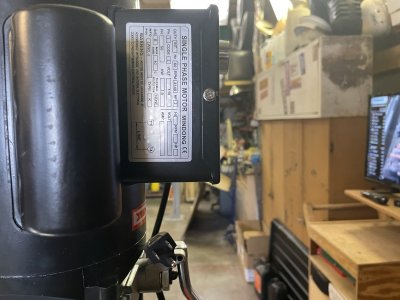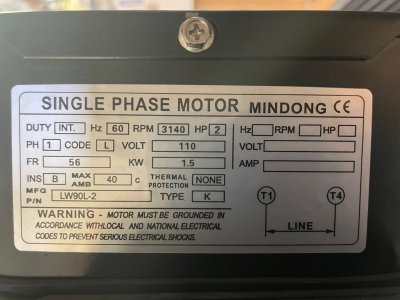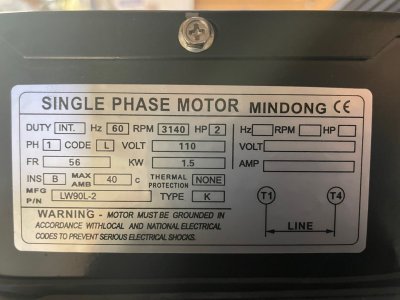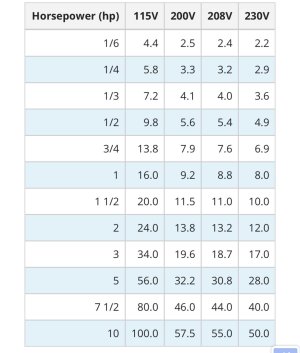Definitely better than laying on your back. Glad everything is working out good for you Doug especially retirement coming up soon. I had. 76 Blazer I bought new I regret so many times of selling that. It was the first year of the metal cab roof. I like your little roll around wood cart looks handy.
You are using an out of date browser. It may not display this or other websites correctly.
You should upgrade or use an alternative browser.
You should upgrade or use an alternative browser.
And more junk.
- Thread starter MFDAC
- Start date
That’s the way mine was Daniel. I had the rust protection warranty and while getting it fixed one of the many times the body shop guy said I had 73 body panels. This was the first year Chevy used metal from China. My Dad bought a new 73 Chevy pickup and just a few years later rust started popping up everywhere. He was so mad.I had an 80 K5 Blazer. Missed it after selling, but seen it just 2 or 3 years after letting it go and made me glad I did, as it's body was literally falling apart from rust cancer.
Thanks for the link Doug.Hopefully this link is correct. There are also two ton unites available that are cheaper.

VEVOR Electric Car Jack Floor Jack 3 Ton Electric Scissor Jack Car Repair Tool 644097101051 | eBay
Find many great new & used options and get the best deals for VEVOR Electric Car Jack Floor Jack 3 Ton Electric Scissor Jack Car Repair Tool at the best online prices at eBay! Free shipping for many products!www.ebay.com
DAC
No sense in envy, Chris, it sounds like you have nowhere to put one. I appreciate you commenting!That's nice Doug. I envy you!
Thanks, Noel, it's been sitting way too long. 18 years. A lot of the components are ready for it. engine, transmission, transfer case, radiator, things like that. My wife and I dated in this thing and I got my first driver's license in it.Always interested Doug. Great pictures. Bd nice to get the 1970 out and going.
Noel
It was probably leaned up against the wall one time when I was coating out sign panels way back when. Sometimes "cleaning" the roller on a piece of raw wood helps it last longer. It got a roller cleaned on it. They will get painted when the tractor platforms get painted.Looking mighty fine. I like the color coding on the tractor planks on the lift.
I didn't build the cabinet, Jim. A co-worker died and I bought it from his widow. He built it. I just changed the wheel setup on it to casters. It holds mostly drilling related stuff like bits, screwdriver bit kits, HF cordless tools, tap and die sets, etc. etc.Definitely better than laying on your back. Glad everything is working out good for you Doug especially retirement coming up soon. I had. 76 Blazer I bought new I regret so many times of selling that. It was the first year of the metal cab roof. I like your little roll around wood cart looks handy.
Like you and Jim, Daniel, I had a similar Blazer too. A '75 I bought from my sister about 30-35 years ago. Last year with the full removable top. The rust wasn't too bad on it but with 2 young kids it was a pain to put car seats in the back. Sold it to buy a 1980 Suburban. Sister was mad about that for awhile. I did miss it too. It was a very solid, nice driving truck.I had an 80 K5 Blazer. Missed it after selling, but seen it just 2 or 3 years after letting it go and made me glad I did, as it's body was literally falling apart from rust cancer.
That era was more rust prone for sure. The flat top on the fender wells didn't help drainage either. The 70-72 era did get rusty also but not quite as bad.That’s the way mine was Daniel. I had the rust protection warranty and while getting it fixed one of the many times the body shop guy said I had 73 body panels. This was the first year Chevy used metal from China. My Dad bought a new 73 Chevy pickup and just a few years later rust started popping up everywhere. He was so mad.
You're welcome Rad. Hope you find something similar or maybe this one that can work for your needs.Thanks for the link Doug.
Just worked on the Jimmy for awhile this afternoon. Ordered a couple of parts from LMC.
DAC
I am trying to figure something out with the lift that has a simple mind like mine confused. For the moment I'm running the motor from a 20A circuit that has nothing but the ceiling fans and the lift on it. Using a cord to it though. Not having any trouble with it tripping the breaker or anything either. BUT the instructions (which pretty much suck) says it needs a 30A circuit. I am guessing that with a 5 or 6,000 pound truck on the lift might be where the breaker trips, rather that the 1500 or so I have on it right now.
I tried to find a normal 3 prong grounded outlet that has a 30A rating. Nothing at Ace or Menards. 30 amp were all different animals than the male end on this control unit's cord.

It looks to me that if I spend a bunch of money buying 50' of 10-2 Romex, a breaker and go through the work of pulling the new wire in and running it to the lift, I still can't get a 30A outlet to plug this thing into.
Here's the motor tag. I don't know what AMB is. Probably a bad Chinese translation for AMP.

Then as I said the instructions suck and I decided that I didn't like pushing the lock lever up to release. Would rather pull it down. I had hooked them up to what looked like the most direct position. Reversed that and re-adjusted the linkage and it works well.
With it raised up it is also good for hanging parts off of to paint too!
DAC
I tried to find a normal 3 prong grounded outlet that has a 30A rating. Nothing at Ace or Menards. 30 amp were all different animals than the male end on this control unit's cord.

It looks to me that if I spend a bunch of money buying 50' of 10-2 Romex, a breaker and go through the work of pulling the new wire in and running it to the lift, I still can't get a 30A outlet to plug this thing into.
Here's the motor tag. I don't know what AMB is. Probably a bad Chinese translation for AMP.

Then as I said the instructions suck and I decided that I didn't like pushing the lock lever up to release. Would rather pull it down. I had hooked them up to what looked like the most direct position. Reversed that and re-adjusted the linkage and it works well.
With it raised up it is also good for hanging parts off of to paint too!
DAC
Ohms law says
I=P/R
1500 watts / 110v = 13.63 Amps
745 watts per HP. 2 HP checks out.
Max amb is probably max ambient temperature you can operate the motor in. 104F
FR would be the frame size.
30amp breaker seems overkill to me! 125% of 13.63 amps is 17 amps. I’d size the cable for 20 amps and a 20 amp breaker
Remember you aren’t protecting the motor with the breaker. You are protecting the cable. If the cable is rated for 15 amps and you have it on a 20 amp breaker the cable will fail and potentially cause a fire instead of knocking the breaker.
No matter which direction you go you want the cable to be stronger than the breaker.
Been a long time since I had to do motor calculations. Going off memory. This is what I’d do. BUT I’m not going to stake your safety or the safety of your property on my memory.
I=P/R
1500 watts / 110v = 13.63 Amps
745 watts per HP. 2 HP checks out.
Max amb is probably max ambient temperature you can operate the motor in. 104F
FR would be the frame size.
30amp breaker seems overkill to me! 125% of 13.63 amps is 17 amps. I’d size the cable for 20 amps and a 20 amp breaker
Remember you aren’t protecting the motor with the breaker. You are protecting the cable. If the cable is rated for 15 amps and you have it on a 20 amp breaker the cable will fail and potentially cause a fire instead of knocking the breaker.
No matter which direction you go you want the cable to be stronger than the breaker.
Been a long time since I had to do motor calculations. Going off memory. This is what I’d do. BUT I’m not going to stake your safety or the safety of your property on my memory.
Last edited:
Aaron is right on the money. A 20amp circuit is fine. It is going to draw significantly more amperage on start up but that only lasts for a second and the breaker is designed for that.
Too small a cable (wiring) will also make it more difficult for the motor to start correctly possibly shortening the life of the motor.Remember you aren’t protecting the motor with the breaker. You are protecting the cable. If the cable is rated for 15 amps and you have it on a 20 amp breaker the cable will fail and potentially cause a fire instead of knocking the breaker.
Last edited:
This is true as well! Need to carry the load to provide adequate current to the motor.Too small a cable (wiring) will also make it more difficult for the motor to start correctly possibly shortening the life of the motor.
At the mine we had to do motor calculations and calculate transformer sizing quite often. Been a few years since I’ve done it! Sizing resistors in Parallel and series circuits…
Glad someone else can confirm that my memory is correct. First time I’ve used ohms law in awhile!
Sorry guys I totally disagree. I would never run a 2hp motor on a 20A circuit most likely using a 12 gauge romex. That’s a typical kitchen circuit for appliances or garage for power tools not a 2hp motor that’s going to grunt on start up and most likely near the end of its lift cycle. You need 25% more amps than that motor is rated to operate with out long term damage and to be safe. I would clip the plug, hardwire a 10/2 romex, and a 30A breaker. This is not an area to cut expenses.
The only thing I’m going by is NEC says to size cables at 125% of amperage. That’s 17 amps.Sorry guys I totally disagree. I would never run a 2hp motor on a 20A circuit most likely using a 12 gauge romex. That’s a typical kitchen circuit for appliances or garage for power tools not a 2hp motor that’s going to grunt on start up and most likely near the end of its lift cycle. You need 25% more amps than that motor is rated to operate with out long term damage and to be safe. I would clip the plug, hardwire a 10/2 romex, and a 30A breaker. This is not an area to cut expenses.
However I do think the reason for the plug is the lift is made to move. If it’s hard wired it can’t be moved at least not easily.
He could do 10-3SO to make the plug cord and then you could use 10-2 romex from the outlet back to the breaker box.
I’d cheap out and grab 10-5SO from work. We have miles of it and run it all with that.
Nice looking lift - will make working on things much easier for you. Looks like it uses a push button to activate the motor which powers the pump to raise the hydraulic cylinder(s) the same as my two post lift. One thing I will suggest is to mount and wire in a separate off / on switch (or breaker) within reach of the area where the button is as a separate safety feature in case the button ever sticks in the on position while being pushed. Nothing worse than releasing the push button expecting the lift to stop at a certain spot only to find out the button is stuck and the vehicle on the lift continues upward - especially if there is an object or person it could come in contact with that can damage the vehicle or the person.
First off I will admit that it's been fifteen years since I was employed so maybe things have changed. If they have I will be happy to accept being corrected.This is not an area to cut expenses.
At that time all wiring, contactors, overload protection and such was rated at 125% of the max load on that circuit. 1 phase or 3 phase that was considered acceptable. We had hundreds of motors operating under these guidelines with no issues. Some of these starting and stopping hundreds of times a day. The information I offered was not intended to be a cost cutting measure.

Something about this tag doesn't make sense to me. It says the maximum draw at 110v is 13.6 amps. At a 115v it's 13.04 amps. If my memory is still working this motor is only about 3/4hp not the stated 2hp.
A 2 hp. 1 ph. motor at 115v should draw 24 amps.
If I were you I would get a good amp probe and find out just what this motor requires (draws) before going any further.
Is this a capacitor start motor?
Last edited:
Wire size for any motor should be 25% more than the motor is rated under full load. 20 Amp motor + 25% = a 25Amp draw at full load. This is too much for a 20Amp breaker and definitely a 12 gauge romex. His next size up would be 30Amp breaker with 10-3 wire. When I mentioned hardwire I’m assuming the motor is stationary since it has a plug. I would clip the plug and wire the motor to a push button switch which would be easy to toggle up and down. As 29 Chevy mentioned a emergency kill switch near by because buttons do hang up. From the switch to the breaker box using the 10-3SO would be good since it’s flexible.The only thing I’m going by is NEC says to size cables at 125% of amperage. That’s 17 amps.
However I do think the reason for the plug is the lift is made to move. If it’s hard wired it can’t be moved at least not easily.
He could do 10-3SO to make the plug cord and then you could use 10-2 romex from the outlet back to the breaker box.
Last edited:
My comment Chris wasn’t targeted to anyone particular.The information I offered was not intended to be a cost cutting measure.
Where are you getting 20amps?Wire size for any motor should be 25% more than the motor is rated under full load. 20 Amp motor + 25% = a 25Amp draw at full load. This is too much for a 20Amp breaker and definitely a 12 gauge romex. His next size up would be 30Amp breaker with 10-3 wire. When I mentioned hardwire I’m assuming the motor is stationary since it has a plug. I would clip the plug and wire the motor to a push button switch which would be easy to toggle up and down. As 29 Chevy mentioned a emergency kill switch near by because buttons do hang up. From the switch to the breaker box using the 10-3SO would be good since it’s flexible.
Most 5hp motors are 15amps. It’s going to draw more on start up and possibly at the end of its lift cycle for what Doug mentioned for a 5-6k lb. truck. I was giving him some wiggle room especially since he might have some good junk in the bed. LolWhere are you getting 20amps?
True but it’s 2HP. But I agree with Chris. 13 amps is closer to 3/4 HP. The KW rating should be 2.6 not 1.5 if it’s in fact 2HP.Most 5hp motors are 15amps. It’s going to draw more on start up and possibly at the end of its lift cycle for what Doug mentioned for a 5-6k lb. truck. I was giving him some wiggle room especially since he might have some good junk in the bed. Lol
I’d say at this point Chris’s idea is best. Amp clamp that sucker with a load on it and see what it is actually pulling. I don’t trust that tag now after thinking more about it!

I’m sorry I meant 2hp not 5.True but it’s 2HP. But I agree with Chris. 13 amps is closer to 3/4 HP. The KW rating should be 2.6 not 1.5 if it’s in fact 2HP.
I’d say at this point Chris’s idea is best. Amp clamp that sucker with a load on it and see what it is actually pulling. I don’t trust that tag now after thinking more about it!
View attachment 66616
